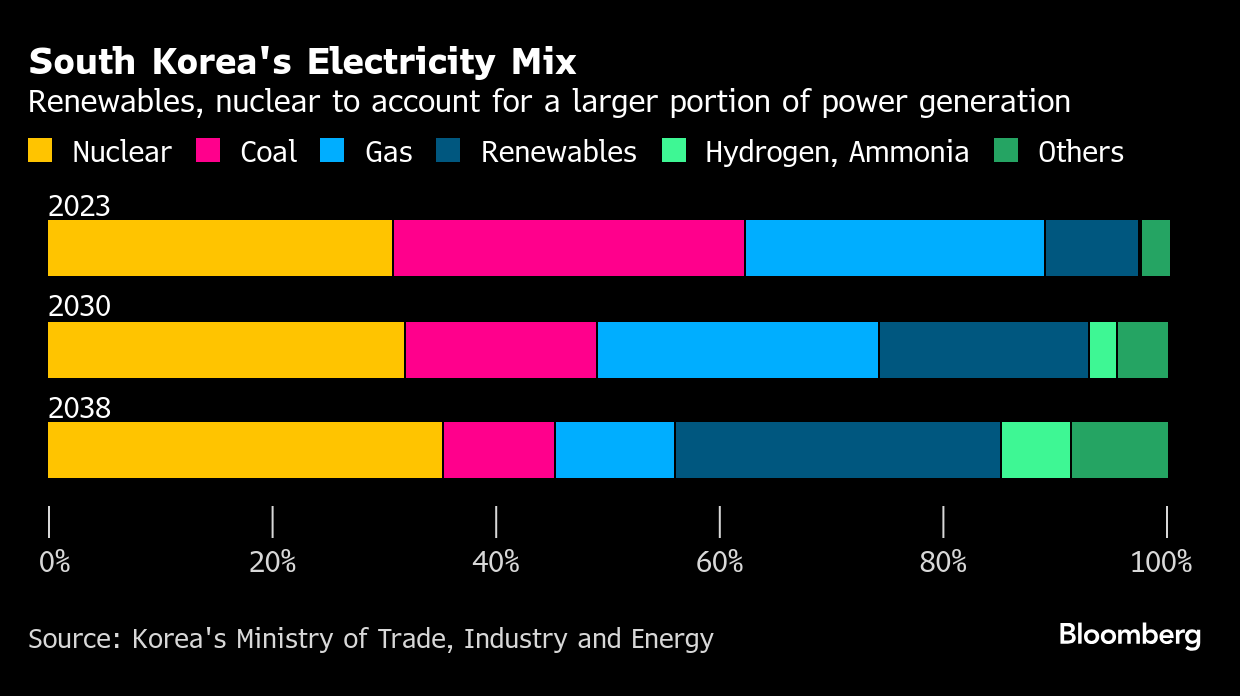Korea Cancels Planned Reactor After Impeaching Pro-Nuke Leader
(Bloomberg) -- South Korea has scaled down its plans for nuclear power after the impeachment of President Yoon Suk Yeol, an atomic energy advocate, gave the opposition party greater influence over the country’s long-term energy policy.
The Asian nation expects to add a total of 3.5 gigawatts of nuclear capacity by 2038, according to a government plan finalized Friday. That’s down from the 4.9 gigawatts proposed in a draft proposal in June. Power from renewables, including solar and wind, will rise slightly to 122 gigawatts, up from 120 gigawatts in the earlier version.
South Korea is scrapping plans for one of three large-scale reactors, each with 1.4 gigawatts of capacity, a move driven by the opposition Democratic Party’s push to rely more on renewable energy. The country still aims to build a 700-megawatt small modular reactor by 2036, while significantly reducing its use of coal and natural gas.

South Korea’s embrace of nuclear energy has come into question after President Yoon’s botched attempt in December to impose martial law led to his impeachment. During his tenure, Yoon had prioritized nuclear power over renewables as a key tool for cutting emissions, and called for building more reactors. That was a sharp reversal from the prior administration’s anti-nuclear policy.
Read Also: Martial Law Fiasco Casts Doubt Over Korea’s Nuclear Power Push
Asia’s fourth-largest economy is heavily reliant on fossil fuels. It has pledged to cut greenhouse gas emissions by 40% from 2018 levels by the end of the decade, a target that lags global peers. South Korea also failed to submit an updated climate goal, due in early February, to the United Nations even after the nation’s Constitutional Court ruled last year that the absence of incremental climate goals from 2030 through 2050 was unconstitutional.
The role of coal and liquefied natural gas will continue to dwindle under the energy plan. LNG will be required for about 11% of electricity generation and coal for 10% by 2038, according to the energy ministry forecasts.
South Korea is also aiming to use hydrogen and ammonia for co-firing in its existing coal power plants, the ministry said. The two fuels will together make up more than 6% of the power mix in 2038.
©2025 Bloomberg L.P.
KEEPING THE ENERGY INDUSTRY CONNECTED
Subscribe to our newsletter and get the best of Energy Connects directly to your inbox each week.
By subscribing, you agree to the processing of your personal data by dmg events as described in the Privacy Policy.
More renewables news

US Green Steel Startup Raises $129 Million Amid Trump Tariff Uncertainty

Spain Signals Openness to Keeping Nuclear Power Plants Open

Musk Foundation-Backed XPRIZE Awards $100 Million for Carbon Removal

As Tesla Falters, These New EVs Are Picking Up the Pace

Fashion Is the Next Frontier for Clean Tech as Textile Waste Mounts

High-Powered Solar Cells Are Poised to Replace Batteries

Nissan Commits Another $1.4 Billion to China With EVs in Focus

NextEra Energy reports 9% rise in adjusted earnings for Q1 2025 as solar and storage backlog grows

US Imposes Tariffs Up to 3,521% on Asian Solar Imports
















